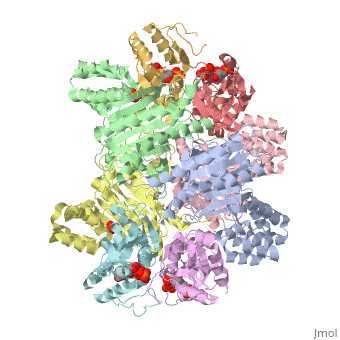ATP Phosphoribosyl Transferase
From Proteopedia
|
Contents |
HisG – ATP Phosphoribosyl Transferase
ATP Phosphoribosyl transferase (ATP-PRTase) (EC 2.4.2.17), also called HisG, belongs to the enzyme super family, phosphoribosyl transferases (PRTases) and the glycosyltransferases family. It catalyzes the reversible condensation of 5-phosphoribosyl-α-1-pyrophosphate (PRPP) with ATP, yielding N’-5’-phosphoribosyl-ATP (PR-ATP) and inorganic pyrophosphate (PPi). 5-phosphoribosyl-α-1-pyrophosphate + ATP = N’-5’-phosphoribosyl-ATP + pyrophosphate.
Four different protein folds are associated with enzymes in the PRTases super family [1]
and ATP-PRTase belongs to the type IV class, a unique fold from all others’;. The presence of four different classes of PRTases points to the fact that these enzyme evolved from different ancestors to perform similar functions, a case of convergent evolution. PRTases possess a conserved P-loop for binding the ribose-5’-phosphate group of PRPP [2].
, , ,
Role of HisG in Histidine biosynthetic Pathway
The reaction catalyzed by ATP-PRTase is the first reaction in the histidine biosynthetic pathway. The reaction also leads to the formation of intermediates involved in purine, pyrimidine and tryptophan biosynthesis. ATP and PRPP are also involved in energy metabolism. Because of the key role of ATP-PRTase in the histidine biosynthetic pathway, a unique pathway for bacteria, plants and fungi but not humans, it is a potential drug target for antimicrobials [3] The biosynthesis of histidine is very energy intensive with about forty-one ATP molecules reported to be consumed during the process. ATP-PRTase is regulated in three ways:
1. Classical feedback inhibition by histidine in an allosteric manner
2. Synergistic inhibition by guanosine tetraphosphate in the presence of histidine
3. Competitive inhibition by AMP and ADP, reflecting the cell’s energy condition
Types of ATP-PRTases
Two forms of ATP-PRTase have been identified:
1. A short form comprising approximately two hundred (200) amino acids which forms a hetero octamer with a regulatory protein HisZ
2. A long form with about three hundred (300) amino acids lacks the HisZ regulatory protein and forms a homo hexamer.
Structure of ATP-PRTase from Mycobacterium tuberculosis[4]
ATP-PRTase has three domains with an α/β fold. The C-terminal domain (domain 3), consisting of a beta sheet with four strands is flanked on one side of the sheet by two helices. The two N-terminal domains house the catalytic site in their interdomain region. Domain 1 has a central beta sheet with three helices around it whilst domain 2 has two helices on each side of a sheet made up of four parallel strands and one anti parallel strand. Domain 2 contains the conserved P-loop motif required for PRPP binding. This motif is thus an essential component of the active site. AMP, a competitive inhibitor of ATP-PRTase binds to residues of the P-loop as well as two residues, Asp 70 and Ser90 of domain 1. ATP-PRTase is active in its dimeric state and inactive in the hexameric state. The dimer interface harbors mainly interactions from domain 1 and 2 whilst domain 3 interactions occupy the hexamer interface. Binding of His to the allosteric site on domain 3 results in a massive conformational shift of the domain 3 whilst domains 1 and 2 undergo very little positional changes.The P-loop motif is only slightly affected by this histidine binding event and that explains why AMP is able to bind to almost the same site as PRPP and competitively inhibit the enzyme. A disulfide bridge is present in the apo enzyme but it is absent in the His- AMP bound version. This could be the effect of the large conformational change that results from His binding.
3D structures of ATP phosphoribosyl transferase
ATP phosphoribosyl transferase 3D structures
Additional Resources
For additional information, see: Amino Acid Synthesis & Metabolism
References
- ↑ Bernhard Lohkamp, Gerry McDermott, Samantha A. Campbell, John R. Coggins and Adrian J. Lapthorn; (2004) The Structure of Escherichia coli ATP-phosphoribosyl transferase: Identification of Substrate Binding Sites and Mode of AMP Inhibition J. Mol. Biol. 336, 131–144
- ↑ 4. Sangita C Sinha and Janet L Smith, (2001), The PRT protein family, Current Opinion in Structural Biology ,11 ,733-739
- ↑ . Yoonsang Cho, Thomas R. Ioerger and James C. Sacchettini; (2008), Discovery of Novel Nitrobenzothiazole Inhibitors for Mycobacterium tuberculosis ATP Phosphoribosyl Transferase (HisG) through Virtual Screening, J. Med. Chem. 51, 5984–5992.
- ↑ Cho Y, Sharma, V and Sacchettini; (2003). Crystal structure of ATP phosphoribosyl transferase from Mycobacterium tuberculosis, J. Biol. Chem. 278, 8333-8339
Proteopedia Page Contributors and Editors (what is this?)
Michal Harel, Alexander Berchansky, David Canner, Lawrence Sheringham Borketey

